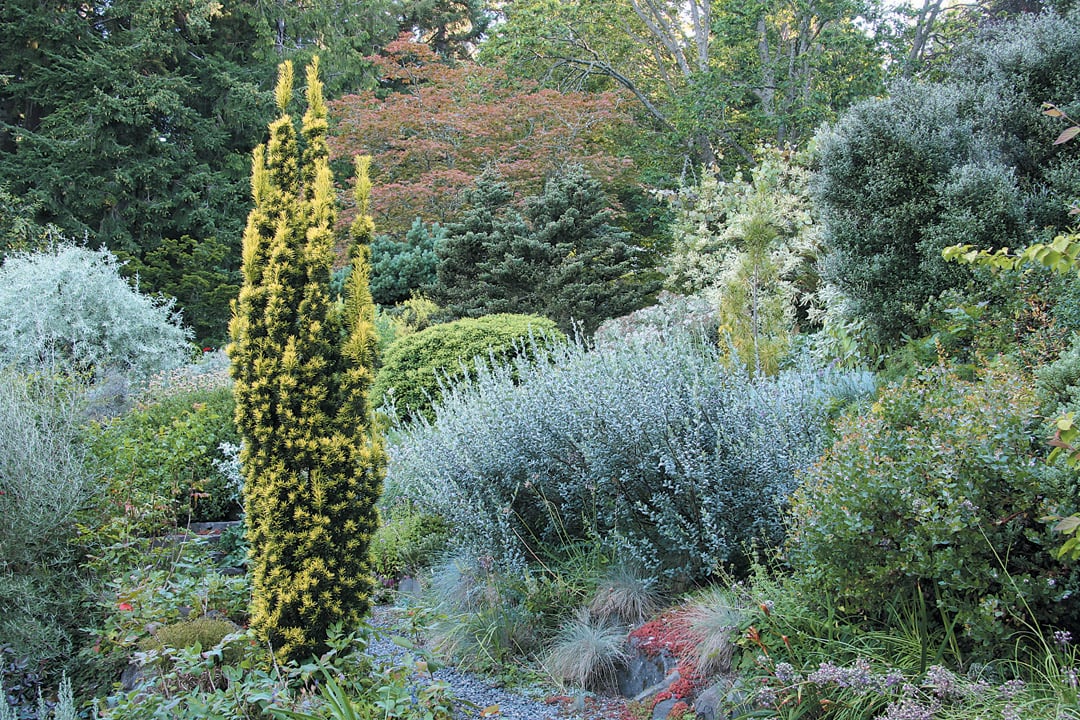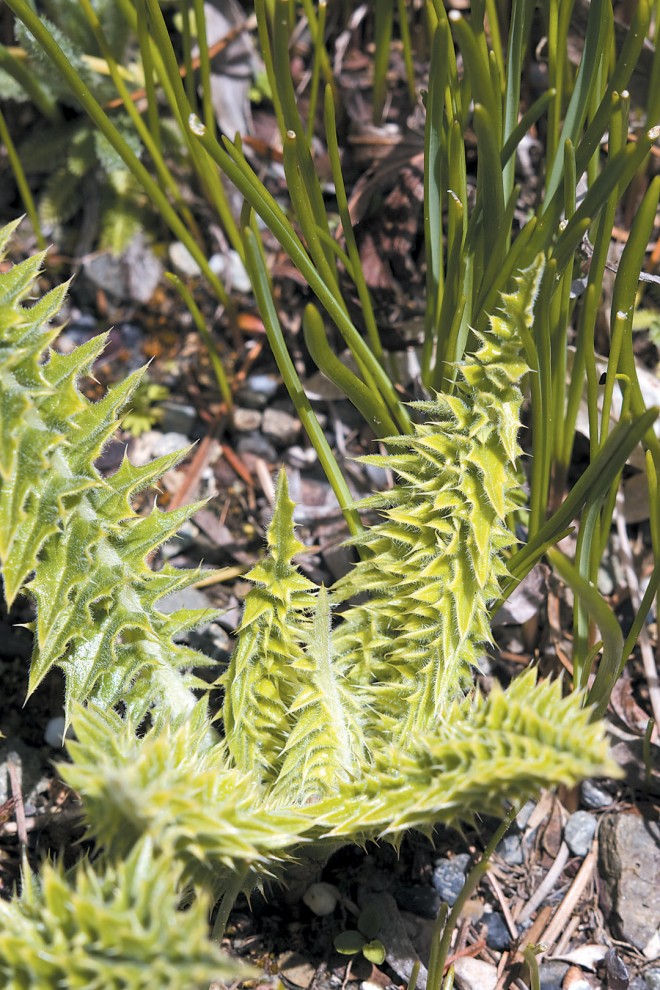

Contributor
- Topics: Archive, Inspired Gardens and Design

Though mostly known for its woodland garden of choice woody and herbaceous plants, the Elisabeth C Miller Botanical Garden also offers a sunny, dry slope that is filled with equally exciting treasures suitable for the water-conserving Pacific Northwest garden.
The careful use of water in the garden is not a new concept for West Coast gardeners. The increasing interest in drought-tolerant landscapes, native plants, and rain-water capture shows the commitment of the gardening community to future generations. Every year advances in techniques and technologies allow us to do a better job of using just enough moisture to allow our gardens to thrive. When Elisabeth C Miller began creating her garden in the early 1950s, she quickly learned the lesson of growing the right plant in the right place. She spent more than forty years experimenting with plants that would adapt and thrive in her north Seattle garden. When the Miller estate was dedicated as a botanical garden in 1994, its mission incorporated an extraordinary blend of plant collecting, environmental responsibility, and educational outreach for the gardening community.
The centerpiece of the garden—and one of the first areas of the garden that visitors see—is a dry, sunny slope featuring an array of plants in varied colors, textures, and forms. This imposing site rises in a gentle slope above the parking lot, gaining about thirty feet in elevation before leveling off to a stylishly rustic, low ranch house that had been the Millers’ home. The slope stretches the entire width of the garden, framed on the north by mature Douglas-firs (Pseudotsuga menziesii) and to the south by an enormous European hornbeam (Carpinus betulus). The entire planting area covers close to one-third of an acre. As Mrs Miller developed the garden, she approached this sunny slope with a plant collector’s passion, some common sense, and a quest for the best plants for the region. We continue to develop this area of the garden following the guiding principles she established.
Seattle’s Dry Summer

Seattle’s modified mediterranean climate is marked by a long rainy season, typically lasting from late September or early October to the fourth of July. Cloudy skies and rain dominate these cooler months, keeping plants damp for weeks. The winter wetness can cause fuzzy leafed plants and succulent foliage to wither and rot. To further complicate matters, arctic blasts can damage late-season growth and hasten the demise of more xeric species. Californians would hardly consider this serious mediterranean gardening, and, in truth, many drought-tolerant staples of the Californian landscape may survive our cool dry summer only to perish in a soggy and frosty death come winter. Our challenge is to find beautiful plants that will tolerate minimal water during the summer but near saturation during winter dormancy. Our success in developing a diverse and interesting planting on this hillside garden can be attributed to the hillside’s extremely sandy soil that provides excellent drainage and allows air to reach the roots in winter; yet, roots can penetrate deeply into the bank to reach reserves of moisture during the dry summer.
About eighty percent of the garden slope is covered with woody plants. Evergreen plants comprise about seventy-five percent of the planting, which gives the hillside a visual stability and constancy through the seasons. Shrubs, especially evergreen shrubs, shade out most weeds and help hide the few that do survive. A range of plant sizes, from small trees to groundcovers, results in a network of roots from the surface to deep into the bank—strong enough to hold the sandy soil in place and minimize shifting soil caused by gardeners weeding and pruning.


Local Natives
Northwest native plants figure prominently in the plantings. The dwarf oaks and oak relatives of the Siskiyou Mountains, which straddle the Oregon/California border, are a backbone of this garden. The delightful and compact deer oak (Quercus sadleriana) was a favorite of Mrs Miller’s, and for good reason: it grows into almost perfect mounds with little pruning, suffers few diseases, and is evergreen. One of the gems of the garden is a slow-growing, compact form of huckleberry oak (Q. vaccinifolia). These dwarf forms occur naturally in the rare serpentine soils of the Siskiyous. After more than forty years in the Miller Garden, ours remains only five feet high with a spread of over fifteen feet, making it the largest of its kind in Washington State. Nearby is a close relative, dwarf tanbark oak (Lithocarpus densiflora var. echinoides). This compact grower will eventually reach fifteen feet tall and wide, but responds well to pruning. The evergreen foliage emerges silver and matures to a leathery gray green.
Many of the shrubs that have thrived on this site have medium- to fine-textured leaves, often with a rounded or mounding habit. Unusual and interesting forms and shapes are crucial for breaking any tendency toward monotony. One of Mrs Miller’s favorite plants was the weeping form of Chinese scholar tree (Styphnolobium japonicum ‘Pendula’, formerly Sophora). From the famous Hillier’s Nursery in England, she obtained five young plants for the outrageous sum (at that time) of $100 each. She kept one and sold the others to close gardening friends, each shocked by the high price for a long slender stick with roots at one end and a single bent weeping twig grafted to the other end. As the years passed, however, her tree formed an impressive weeping tangle of bright green twigs, especially striking in winter when the intricate branching can be fully appreciated.

Columnar plants were carefully sited to contrast with the mounded forms of neighboring shrubs. A group of slow-growing, columnar golden yews (Taxus baccata ‘Standishii’) stand as slim spires working their way up the bank. Their golden foliage plays well off the silvers, grays, and olive greens that dominate the hillside. One of the more unusual columnar plants is a recent addition: an uncommon narrow form of Japanese umbrella pine (Sciadopitys japonica ‘Joe Kozey’). In future years, it will be a focal point for the garden.


Attractive Foliage Reigns
The corokias native to New Zealand have an odd habit, with branches growing in a twiggy, zigzag pattern. A grouping of five Corokia cotoneaster dot an area of the slope referred to as the gray garden because of the abundance of gray and silver foliage. The dark charcoal-colored stems create a loose columnar tangle of stems only interrupted in spring by a scattering of small bright yellow star-shaped flowers and in fall and winter by red berries. Corokia xvirgata is a marginally hardy shrub in our climate, but a specimen of its cultivar ‘Bronze King’ has made it through the last twelve winters and is now the largest of its kind in Washington. Reaching nine feet tall and about seven feet across, its gray and bronze brown foliage and twisted stems are a strange, yet compelling centerpiece on the slope.
Many plants have been selected for their eye-catching leaves. The super-fine, thread-like leaves of giant fennel (Ferula communis) lend a soft, fresh green, feathery touch in winter and spring. As the weather warms, the growth is robust with stems exceeding eight feet or more in height, topped by enormous umbels of chartreuse flowers. The entire plant disappears during its summer dormancy.
We have tried many of the wonderfully architectural agaves, so popular in California and the Southwest, but few will tolerate the constant dampness and winter temperatures at the garden. We have learned to be satisfied with yuccas and other perennials with architectural qualities. The strappy and spiky leaves of agave seaholly (Eryngium agavifolium) add this type of texture to the garden. A short-lived perennial, it will gently reseed about the bed, often popping up in the most unexpected of spots to fill bare holes and tight niches.

Acanthus are excellent foliage plants and about as tough as a perennial can be, but most are larger than we want for our hillside garden. The exception to this is Acanthus dioscoridis var. perringii, a more compact bear’s beach with extra spiny leaves. A formidable flush of growth emerges in late winter, peaks in early summer with a handful of flowering spires, and withers in summer dormancy as dry weather settles in.
Mrs Miller enjoyed hollies for their glossy, deep green leaves and their ability to withstand abuse. One of the best is Ilex aquifolium ‘Angustifolia’, several of which are lightly pruned into dense tear drops. These male forms do not set seed and add a deep shiny black green color to the hillside. Close inspection reveals fine spines along the edge of each leaf and deep purple stems that set off the evergreen foliage.
Great foliage is not confined to broadleaf plants; conifers can provide outstanding foliar interest as well [see also Pacific Horticulture, April 2011]. Two recently added conifers have especially unusual and colorful growth. One of the most curious is Podocarpus ‘Orangeade’. In winter, the pointed needles become a deep burnished bronze with a dark green undertone; when the new growth starts, it is an odd golden orange maturing to olive-green.
I used to regard Norway spruce (Picea abies) and most of its cultivars as merely utilitarian. One selection proves this generalization wrong: Picea abies ‘Pusch’ is a low compact grower, bearing copious numbers of miniature, bright reddish purple cones that sparkle in the fresh green new growth of spring.

Brightening the Gray Days
Silvers and grays feature prominently throughout the hillside, adding an indispensable lightness to the bank and a feeling of warmth and sunshine on otherwise dull days. A major focal point is a young silver weeping pear (Pyrus salicifolia ‘Pendula’). For many years, I could not understand the esteem accorded this plant, which is prone to erratic branching and formless structure. Others loved the tree. I decided to prune it without remorse. Over the last several years, it has finally started to take on a pleasingly controlled wildness; the strong silver gray foliage is echoed by the paler green gray of Phlomis fruticosa ‘Compact Gray’, oddly named for, without periodic heavy pruning, it will reach five feet tall with a seven-foot spread. The bolder texture of the leaves and the profuse spikes of canary yellow flowers in summer are outstanding; the blossoms are held in tight whorls along the stem, each flower filled with sweet nectar.

In experimenting with various shrubs, we have added several kinds of New Zealand daisy bush (Olearia), most of which have succumbed to cold temperatures over the years. The hardiest form for us is Olearia xmollis, which slowly reaches seven to eight feet tall; we occasionally prune it to the ground and encourage it to re-grow. Its simple oval leaves are a soft olive gray with a whitish cast. In early summer, it is covered with a profusion of tiny white, daisy-like flowers.
It is always fun to have the unexpected in a planting. Most gardeners would not think a dry bank would be a fitting place for a willow, but silver creeping willow (Salix repens var. argentea) thrives here. Native to the coastal dunes of Europe, it tolerates the quick drainage and dry soils without loosing a leaf.
The beauty of soft colors, varied textures, and distinct forms make for a drought-tolerant landscape that knits together in all seasons. The most exciting part of the planting is knowing there is always room for improvement and experimentation. Mrs Miller stated “When you plant a seed, the rest will follow.” Her hillside garden thrives today from the ideas she sowed years ago.
Share:
Social Media
Garden Futurist Podcast
Most Popular
Videos
Topics
Related Posts

Ground Up Science for Greener Cities with Garden Futurist Dr. Alessandro Ossola
Spring 2023 Listen to the Podcast here. Alessandro Ossola is a scientist who gets very excited about the challenge of climate change allowing for an

Readying Urban Forests for Climate Realities with Garden Futurist Dr. Greg McPherson
Winter 2023 Listen to the Podcast here. “Going from the mow and blow to a more horticulturally knowledgeable approach to maintaining the landscape. And that

Low Maintenance Gardens – Better for Pollinators and People
Autumn 2022 “I come out every day. It’s therapy, my meditation.” Janet’s young garden transformed from overgrown, invasive plants to mostly natives. The dailiness of

Invasive Plants Are Still Being Sold: Preventing Noxious Weeds in Your Landscape
Autumn 2022 With so many beautiful ornamental plant species and cultivars throughout California and the Pacific Northwest, how do you decide which ones to include










Responses